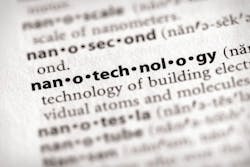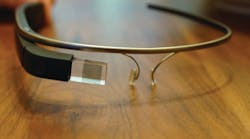Nanotechnology holds promise for security applications
The world today is seemingly filled with multiple threats from every direction and of every type; physical damage caused by fire or water, natural events like seismic activity or floods, disruption of essential services like electricity or communication, and compromise or loss of information. In most cases, it is obvious that damage has been done. Computers may no longer be operative, physical structures may be destroyed and communication systems may not work. However, in the case of the more insidious harm that may be caused by chemical, biochemical, radiological or disease-causing agents, it may be some time before overt effects can be detected.
In order to be able to take appropriate reparative or preventative countermeasures, it is imperative to be able to discover a threat as soon as possible. However, traditional methods for detecting chemical and biological agents are often slow and require skilled labor. If we are to minimize the effects of a hostile intentional action, detection instruments must not only be accurate, highly specific, compact, operational for long periods of time, and capable of being easily deployed, but they also must be able to detect substances that were not traditionally a concern. These include the gaseous chemical signals emitted by pathogens, diseases, pesticides, toxins and explosives. Without an appropriate surveillance program it is likely that the first indication that an attack has occurred will be when multitudes of people show up for treatment in hospital emergency departments.
Sensor technology, especially using engineering developments centering on nanotechnology, hold great promise for the early detection of disease. Indeed, we are now at the point with nanosensor technology that individual molecules can be identified. Researchers at the Fresnel Institute in Marseille, France, have created an optical device the size of a large protein molecule that detects biological molecules using fluorescence brightness in sample sizes stated to have the smallest observation volume in the world. This technology could be incorporated into instruments used for early diagnosis of disease markers.
For several years now, it has been recognized that nanostructures, such as nanotubes and nanowires (some of the functional building blocks of nanotechnology ranging from 1 to 100 nanometers in size) and sheets and ribbons of graphene (a two-dimension sheet of carbon atoms arranged in a lattice) have the ability to sense gases due to their very high surface-to-volume ratio and surface adsorption. The latter is the same phenomenon by which activated charcoal in a gas mask attracts toxic gas molecules and allows the person wearing the mask to breathe uncontaminated air. Altering both the chemical composition of the surface and the shape of the underlying nanostructure allow different gases to be adsorbed. When these gas molecules adhere to the surface, the electrical properties of the substrate change and permit measurement of both the type and concentration of the gas.
Using these techniques, an “electronic nose” is under development by Professor Nosang Myung at the University of California, Riverside. This device uses an array of carbon nanotubes to detect airborne toxic substances at a level of parts per billion. It is anticipated that the sensor would be used for detecting chemical warfare agents, gas leaks, volatile organic compounds and toxic pesticides. The early prototype model was reported to be about four by seven inches in diameter. The goal is to reduce that to the size of a credit card and, ultimately, the size of a fingernail so that it could be incorporated into a variety of platforms, including smartphones, handheld devices and wearable formats. The human skin is known to produce volatile organic compounds that are associated with diseases that include cancers, genetic disorders and viral and bacterial infections. This sensing technology could also be used for disease detection as well.
We have all become used to being scanned at the airport with imaging systems using terahertz radiation. Researchers at the University of Pittsburgh have described a detector using this same radiation that can now detect individual molecules. Rather than a body scanner, it is a molecule scanner that could eventually open the way to a variety of practical applications that might include chemical threat detection.
James McGrath at the University of Rochester has created microscopically thin silicone nanomembranes that can be used as separation tools for biological materials. This advance could lead to credit card-sized medical devices (a “laboratory-on-a-chip”) that are inexpensive, easily portable and able to detect biological agents such as anthrax. Due to their minuscule size they work with only about a quarter volt of electricity, meaning that the power requirements can be met by small, long-lasting batteries.
The microscope has also traditionally played a key role in medical diagnosis. The ability to make specialized microscopes more portable would have distinct advantages for early disease detection and diagnosis. The laboratory of Aydogan Ozcan at the University of California in Los Angeles has developed a fluorescent microscope that can be mounted on a smartphone and used to detect viruses and bacteria, eliminating the need for expensive and cumbersome lab equipment. The ability to substitute small and portable devices for other sorts of laboratory-based equipment is increasing rapidly as well. A research team in Israel has used a common green laser pointer to create a portable Raman spectrometer that has the capability of rapidly detecting small levels of toxic chemicals.
Other disease detection methods are similarly being enhanced. Scientists at the University of Toronto’s Institute of Biomaterials and Biomedical Engineering have created a biosensor using DNA powder and gold nanoparticles that facilitates rapid detection of a variety of infectious diseases from a single drop of blood or saliva. Multiple diseases can be tested from a single sample. The DNA powder is stable for years, meaning that testing materials can be stockpiled, prepositioned at multiple locations and available for use quickly. Chemists at Johannes Gutenberg University in Germany have developed a nanosensor about the size of the head of a pin that can identify proteins in blood, saliva or other body fluid and differentiate between harmless and dangerous bacteria. The technique used could also be appropriate for detecting illicit drugs or toxins in the environment or in food.
Complementary to detecting disease agents and toxins is the ability to determine which treatment agents will be effective. To that end, Army scientists at the Edgewood Chemical Biological Center have built a “human-on-a-chip.” This device contains a small patch of human tissue, created from stem cells, that will mimic an actual organ such as the heart, liver, lung or nervous system, to determine how the body reacts to chemical warfare agents and which treatment options are most effective.
A biologic or chemical attack resulting in large numbers of affected individuals would stress traditional methods of making medical assessments to the limit. Blood glucose levels, for example, are usually monitored by using a lancing device on the side of a finger to obtain a drop of blood which is then absorbed by a test strip that is placed into a meter. Although simple, effective and accurate for an individual who has diabetes, this method may not be practical in terms of time, expense and supply availability when dealing with measurements scaled up by several orders of magnitude. However, Mitchell Lerner and his associates at the University of Pennsylvania have constructed a glucose sensor built upon carbon nanotubes coated with molecules that bind to glucose. Devices built using this technology would do away with finger sticks since they are sensitive enough to detect glucose levels in saliva. These nanotube-based sensors would also be much cheaper than the enzyme-based test strips currently available.
Potential radiologic threats in the environment can currently be reliably detected with portable radiation detectors that have been deployed as part of the Intelligent Radiation Sensing System developed by the Department of Homeland Security. If that system should be compromised or bypassed, however, and people were to be exposed to dangerous levels of ionizing radiation, the current methods to determine the magnitude of exposure are either a blood test which measures chromosomal changes or by simply observing whether physical symptoms develop. Both methods take several days before results can be obtained and this would be much too long to initiate optimal treatment. Fortunately, scientists at the Lawrence Berkeley National Laboratory and Stanford University have developed a chip with a nanosensor array that can measure the concentration of blood proteins known to change following radiation exposure. The test using this system needs only a single drop of blood and can effectively triage people who may have been exposed to radiation. Eventually the investigators hope to develop a hand-held device that “lights up” to indicate a person who needs treatment following the exposure.
Affected individuals will also need to have continuing medical monitoring on a short- and long-term basis. While that can be a relatively simple endeavor with only a few persons involved, the task can be daunting when the number of victims is in the hundreds or thousands. Proteus Digital Health has developed, and received clearance from the Food and Drug Administration for, an ingestible wireless sensor technology the size of a grain of sand that, along with a wearable device and a cell phone, can monitor physiologic parameters the include heart rate, temperature and activity patterns. The Proteus system is operational for only a short period of time, but a sensor using carbon nanotubes implanted under the skin, developed by Michael Strano at the Massachusetts Institute of Technology, can measure substances for much longer, perhaps even a year.
As ingestible, implantable, wearable and portable sensor monitoring systems develop and are enhanced, it is inevitable that their capabilities will continue to improve over time and, if incorporated into a multimodal medical sensor network (similar to that currently employed by some hospitals to track staff and equipment), will be able to automatically assess threats in the environment and monitor the health status of large numbers of patients to determine the efficacy of treatment.
About the Author: Dr. Steven Hausman is President of Hausman Technology Presentations and Consulting (www.HausmanTech.com). He speaks professionally and conducts briefings on a wide array of topics related to technology, science and security that include nanotechnology, robotics, 3D printing, bionics (artificial limbs and organs) and radio frequency identification (RFID). He can be contacted via his website or his LinkedIn profile at http://www.linkedin.com/in/stevenhausman.



